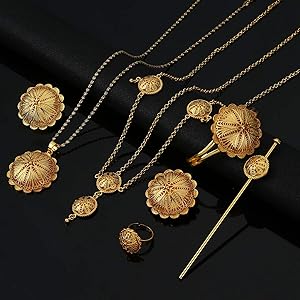
Jewelery companies in Ethiopia
Ethiopia has a rich history in jewelry craftsmanship that reflects the cultural diversity and ancient heritage of the region. Ethiopian jewelry is known for its intricate designs, traditional techniques, and the use of unique materials, including silver, gold, and precious stones. Over the years, jewelry-making in Ethiopia has evolved, giving rise to various companies and artisans who blend traditional Ethiopian designs with contemporary styles.
1. Origin and Cultural Significance
Jewelry in Ethiopia has roots that go back thousands of years. Influenced by the ancient kingdoms of Aksum and the regional Ethiopian Orthodox Church, Ethiopian jewelry often incorporates intricate designs, religious symbols, and cultural motifs. Jewelry pieces, such as crosses, necklaces, and rings, have been essential symbols in Ethiopian ceremonies and are highly valued in the cultural fabric of society. Even today, Ethiopian jewelry artisans draw inspiration from these historic and spiritual elements to create pieces that resonate with both local and global customers.
2. Materials and Techniques
Ethiopian jewelry is often made from high-quality silver, gold, and brass, with the occasional use of copper and other alloys. Ethiopian jewelers are particularly renowned for their filigree and granulation techniques, which involve creating detailed patterns by twisting fine threads of metal and attaching small metal beads to create complex designs. Traditional Ethiopian crosses, typically crafted from silver, are one of the country’s most recognized jewelry items and reflect a variety of regional styles.
In addition to precious metals, Ethiopian jewelry makers have started using local gemstones, including opal, the country’s national gemstone. Ethiopian opal, found primarily in the Welo region, has garnered international attention due to its vibrant colors and quality. Many jewelry companies in Ethiopia are now incorporating opal into their designs, which has helped Ethiopian jewelry gain a presence in global markets.
3. Leading Ethiopian Jewelry Companies
Some Ethiopian jewelry companies and brands are gaining recognition for their craftsmanship and dedication to quality. These companies range from small artisan workshops to larger enterprises that produce jewelry for both local and international markets.
Lucy Jewelry: Named after the famous fossil discovered in Ethiopia, Lucy Jewelry is known for incorporating Ethiopian cultural motifs and symbols into its designs. The company produces a range of items, from traditional Ethiopian crosses to modern rings, bracelets, and necklaces, often using Ethiopian opals and silver.
Addis Ababa Jewelry: Based in the capital city, Addis Ababa Jewelry is one of the larger jewelry makers in Ethiopia, producing both traditional and contemporary designs. The company focuses on producing pieces for weddings, religious ceremonies, and other cultural events, catering to the domestic market while expanding internationally.
Ethiopian Artisan Jewelry Collective: This organization brings together various artisans and small-scale jewelry makers across Ethiopia, providing them with resources and training to produce high-quality pieces. The collective aims to promote traditional Ethiopian jewelry-making techniques while encouraging artisans to innovate and create modern styles.
Yefikir Design: Although primarily a fashion and accessory brand, Yefikir Design incorporates Ethiopian jewelry into its collections. Founded by Fikirte Addis, the brand is known for its unique approach to combining traditional Ethiopian motifs with modern aesthetics. Yefikir Design’s jewelry pieces often use a mix of metals and Ethiopian opals, making it a popular brand in both local and international markets.
4. Challenges and Opportunities
While Ethiopian jewelry companies have strong craftsmanship and unique designs, they face challenges related to global competition, limited access to advanced tools, and a lack of consistent access to precious metals and stones. However, with the growing global interest in sustainable and ethically sourced jewelry, Ethiopian companies have an opportunity to leverage their handmade techniques and local materials to appeal to the global market.
Additionally, the Ethiopian government has shown interest in promoting the jewelry sector as part of its broader economic development plans. By encouraging local production and facilitating access to international markets, the government aims to support Ethiopia’s artisanal sector and enhance the country’s jewelry exports. Efforts to promote Ethiopian opal on the global market have also benefited local jewelry companies, allowing them to capitalize on the unique appeal of Ethiopian gemstones.
5. International Appeal
With its unique designs, cultural symbolism, and quality craftsmanship, Ethiopian jewelry is gaining popularity outside of Ethiopia. Many international consumers are drawn to the spirituality and history embedded in Ethiopian pieces, especially the traditional crosses and opal jewelry. Ethiopian companies are now increasingly participating in international exhibitions and trade fairs, where they showcase their work and establish connections with global buyers.
Conclusion
Ethiopian jewelry companies represent a vibrant and culturally rich sector within Ethiopia’s economy. By blending ancient techniques with modern aesthetics and capitalizing on local gemstones like opal, Ethiopian jewelry is poised to grow further in the international market. The jewelry makers in Ethiopia not only provide a glimpse into the country’s heritage but also highlight the skill and artistry of Ethiopian artisans, who continue to captivate customers worldwide with their unique creations.



Leave a Reply